Dearest readers, do you know what is the largest and tallest stone Buddha statue in the world? Allow Tita S to tell you 13 facts about it.
1.The Leshan Giant Buddha is a 71-meter (233 feet) tall stone statue, built between 723 and 803, during the Tang Dynasty1, depicting a seated Maitreya2, with hands resting on his knees.
Watch this 2:28-minute video: https://www.youtube.com/watch?v=gFvWm8uDnRo.
2. It is the largest and tallest Buddha statue in the world. It is also the tallest pre-modern statue in the world and the largest stone-carved Buddha in the world.
It is ten stories high, as tall as the Statue of Liberty, if this Buddha stood upright.

Photo source: Ariel Steiner, own work, CC BY-SA 2.5, created 8 June 2005, https://en.wikipedia.org/wiki/Leshan_Giant_Buddha#/media/File:Leshan_Buddha_Statue_View.JPG
3. It is carved out of a cliff face of Cretaceous3 red bed sandstones at the Lingyun Mountain’s Qigeng Peak, that lies at the confluence of 3 rivers – the Minjiang River, Qingyi River, and Dadu River – in the southern part of Sichuan4 province in China, near the city of Leshan5.
The entire art piece is built in stone, except for the ears that were designed in wood, covered with mud on the surface to make clay, and attached to the head.
4. The stone sculpture faces Mount Emei6, with the rivers (stated above) flowing below its feet.
5. Buddha’s body is placed in a symmetrical posture and the proportions of the various body parts are proportioned in accordance with the Buddharupa7 requirements of a statue. It has a calm form, which conforms to the Tang Dynasty1 style.
6. The hair is composed of 1,021 spiraled curls embedded in the head that measures 14.7 m (48 ft) in height and 10 meters (33 feet) in width. The ears, 7 m (23 ft) long, are capable of holding 2 people inside. The eyebrows and nose are 5.6 m (18 ft) long, and the fingers are 8.3 m (27 ft) long. The mouth and each of the eyes have a width of 3.3 m (11 ft).
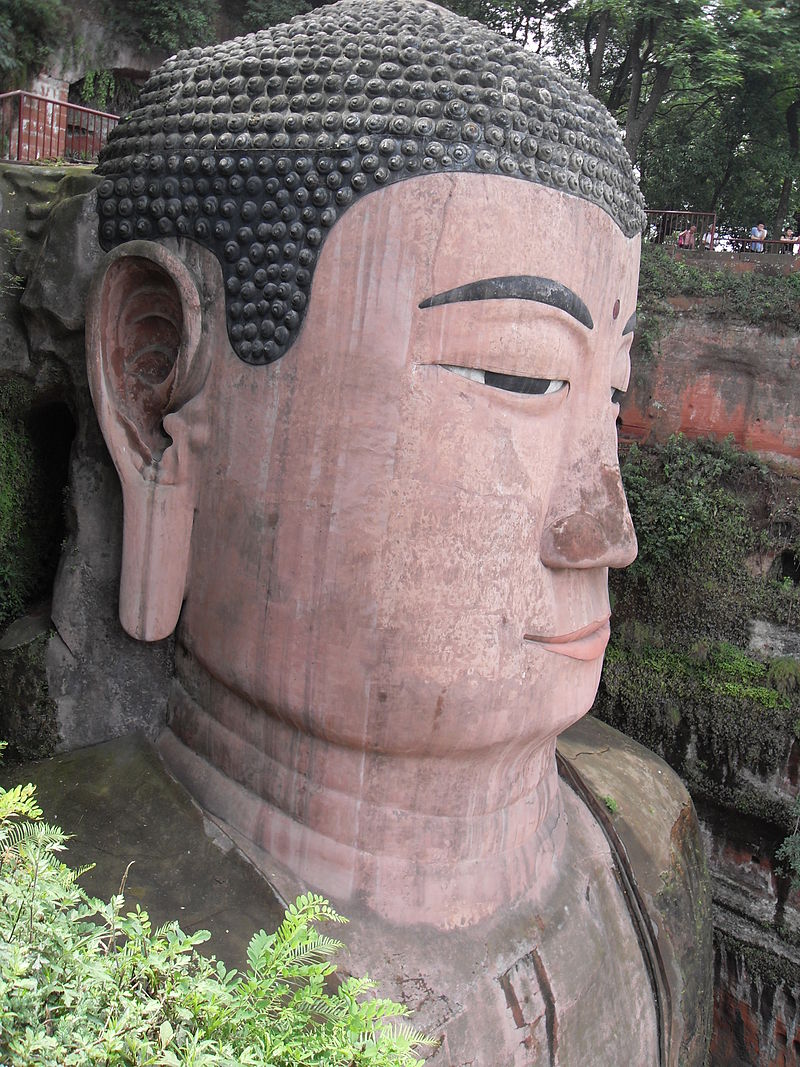
Photo source: BrightRaven, own work, CC BY-SA 3.0, created 19 May 2009, https://en.wikipedia.org/wiki/Leshan_Giant_Buddha#/media/File:Leshan_Giant_Buddha_head.jpg
His shoulders are 24 m (79 ft) wide and his smallest toenail is large enough to easily accommodate a seated person. His instep is around 8.5 m (28 ft) in width and can hold about a hundred people.
7. The operating hours are 7:30 AM – 6:30 PM from April to October, and from 8:00 AM – 5:30 PM from October until March. Remember, weekends and holidays have more tourists, so go on weekdays.
The most convenient way to get to Leshan Giant Buddha from Leshan5 Town is through local bus 13. You can buy a ticket at CNY8 90 per person (check online for current price and entry status for tourists), and this includes a visit to Mahao Cliff Tomb9 and a nearby temple.
There is a pedestrian pathway that allows visitors to get a closer look of the statue and appreciate the changing view of its body through multiple perspectives. Just be careful since the plank pathways are steep and narrow.
There are also sightseeing boats good for 35 passengers, and costs CNY8 70 per person. Just be prepared to wait in line.
The adventurous can explore the different pathways throughout this mountain too.
8. The Mount Emei6 Scenic Area, including Leshan Giant Buddha Scenic Area10, has been listed as a UNESCO World Heritage Site since 1996, in the World Cultural and Natural Heritage List.
It is one of the 5 World Cultural Heritage sites in the province of Sichuan11, the second most popular provincial attraction, with almost 3 million visitors per year.
9. This statue was designated as a cultural relic and was protected by the Sichuan Provincial People’s Committee after the founding of the People’s Republic of China in 1956.
In 1998, the Leshan Giant Buddha Scenic Area Management Committee was formally established.
In 2008, the Mount Emei-Leshan Giant Buddha Scenic Area Management Committee was formally established, with the main task of developing tourism resources for the said area.
10. Construction started in 723 AD, led by a Chinese monk named Hai Tong. He hoped that the Buddha would calm the turbulent waters that plagued the ships traveling along the rivers.
Funding was insufficient so the statue was only completed from the shoulders up. Several years after his death, his disciples continued the work on the statue with financial support from Zhangchou Jianxiong, a local official, but only until the knees since the latter was called to work at the royal court in Chang’an12.
Seventy years later, Jiedushi13 Wei Gao14 decided to sponsor the project and the construction was completed by Hai Tong’s disciples in 803.
11. A sophisticated drainage system was incorporated into this statue when it was built, and you know what? It is still in working order.
It includes drainage pipes carved into various places on the body, to carry away the water after the rains so as to reduce weathering. The advanced drainage system located behind the Buddha’s head and between his two ears preserves it from erosion. The hidden gutters and channels scattered in the hair, collar, chest and holes in the back of the ears and chest carry out the rainwater to keep the inner areas dry. This architectural system prevented the erosion of this statue for more than 1,200 years!
When this statue was carved, a huge 13-storey wood structure was built to shelter it from the rain and sun but this structure was destroyed and sacked by the Mongols during the wars at the end of the Yuan Dynasty (1271 – 1368). From then on, the stone structure was exposed to the elements.
12. This statue was damaged at the beginning of the Northern Song Dynasty (960 – 1279). The body was covered with moss and the wooden pavilion had collapsed.
During the reign of Song Renzong15, the Giant Buddha was repaired once on a large scale, and the wooden pavilion was rebuilt. Records of succeeding destruction and reconstruction of this statue have been missing and the original temple, Lingyun Temple, had been destroyed by war many times.
13. According to Xinhua News Agency, this statue, along with other Chinese natural and cultural heritage sites in the region have been affected by weathering, air pollution, and the influx of tourists. The government planned restoration work.
In March 2002, the first phase of the repair project by the World Bank officially started. This involved completely renovating the Buddha from the chest up to the head, and strengthening the rock wall. On June 23, 2002, the second phase started, which entailed the repair of the feet and the eroded part of the rock below water level.
The information was obtained from the Wikipedia page “Leshan Giant Buddha.”16
So, did Tita S convince you to include this attraction in your China travel bucket list after safe travel will again be allowed? Search for Sichuan tours, like in https://www.chinadiscovery.com/sichuan/tourism/world-heritage-sites.html#1, and tell Tita S about your experience.
This is not a sponsored post. I just want to share with my readers about this stone statue.
Photo source of the Buddha picture used in the cover photo collage: Ariel Steiner, own work, CC BY-SA 2.5, created 8 June 2005, https://en.wikipedia.org/wiki/Leshan_Giant_Buddha#/media/File:Leshan_Buddha_Statue_View.JPG
Heads up: Before planning to travel, always get updates regarding local government status, rules, restrictions and safety measures of the destination/s you want to visit, taking into consideration your personal health conditions, and level expectations.
Did you find this post informative? I would like to hear your comment about the Leshan Giant Buddha, especially sharing your experience and photos, if you were able to go there during pre-Covid times.
See other interesting places through other posts in this category and other categories of SCapades, Pinoy Delights, and Smart Travelers – Foreign Travelers Ask, Now You Know, and Say, Say, Say. Happy reading, and I hope that you will appreciate what I shared and some of the featured destinations will be part of your future travel plans!
Do share this post with your Facebook friends, follow me by clicking on the bottom right corner of your device, and do not forget to like this post. Thank you.
– – – – – – – – – – – – – – – – – – – – – – – – – –
The following terms are defined for interested readers, especially those with “Senior-Moments”, those not familiar with terms used in this post, and those too busy or lazy to Google such terms:
1The Tang Dynasty was an imperial dynasty of China founded by the Li family after seizing power during the decline and collapse of the Sui Empire. It started in 618, with a period of progress and stability during its first half.
This dynasty is regarded as the golden age of cosmopolitan culture and a high point in Chinese civilization because Chinese culture flourished and further matured during this period. It is traditionally considered the greatest age for Chinese poetry. Woodblock printing, a method of printing on textiles and paper, was developed too.
There was an interregnum between 690 and 705 when Empress Wu Zetian seized the throne from her son, the Emperor Ruizong of Tang, proclaiming the Wu Zhou dynasty and became the only legitimate Chinese Empress Regnant. This lasted until Emperor Zhongzong of Tang was restored to the throne.
The An Lushan Rebellion (755 – 763) led to the decline of the central authority in the dynasty’s latter half, and ultimately ended the dynasty after 289 years, in 907. It was followed by the Five Dynasties and Ten Kingdoms Period.
The information was obtained from the Wikipedia pages “Tang dynasty”17 and “Zhou dynasty (690-705)18.
2Maitreya, or Metteyya, is regarded as a future Buddha of this world, the successor to the present Buddha, Gautama Buddha. In some Buddhist literature, the being is referred to as Ajita.
Maitreya is a bodhisattva19 who will appear on Earth in the future, achieve complete enlightenment, and teach the pure dharma (cosmic law and order). He is typically pictured seated, with either both feet on the ground or crossed at the ankles, on a throne, waiting for his time. He is dressed in the clothes of either a bhiksu (monk) or Nepali royalty.
The information was obtained from the Wikipedia page “Maitreya”20.
3The Cretaceous is a geological period that lasted from about 145 to 66 million years ago (mya). It is usually abbreviated K, for its German translation Kreide. It is the third, longest, and final period of the Mesozoic Era21.
It was a period with a relatively warm climate and dinosaurs continued to dominate the land. The world was ice-free, and forests extended to the poles. New groups of mammals and birds appeared. At its early stage, flowering plants appeared and began to rapidly diversify to become the dominant group of plants across the Earth. It ended with large mass extinction where many dinosaurs and invertebrates disappeared, caused by climate and atmospheric causes, along with the fall of a large asteroid.
The information was obtained from https://www.euston96.com/en/mesozoic-era/#Characteristics_of_the_Mesozoic_era and the Wikiepdia page “Cretaceous”22.
4Sichuan is a landlocked province23 in Southwest China, with the city of Chengdu as its capital. It occupies most of the Sichuan Basin and the easternmost part of the Tibetan Plateau, between the Daba Mountains in the north, the Jinsha River on the west, the the Yungui Plateau to the south. It was one of the most productive areas of China in the 19th century.
The area’s warm damp climate encouraged spicy dishes, and the native Sichuan pepper helped to form modern Sichuan cuisine, making Kung Pao Chicken and Mapo Tofu as staples of Chinese cuisine worldwide.
The information was obtained from the Wikipedia page “Sichuan”.24
5Leshan, formerly called Jiading or Jiazhou, is a prefecture-level city25 located at the confluence of the Dadu and Min rivers in Sichuan4 Province22, China. It has an area of 12,827.49 km2 (4,952.72 sq mi).
It features the following tourist attractions: the Mount Emei6 Scenic Area, including the Leshan Giant Buddha10; the Oriental Buddha Park (a privately run cultural theme park with thousands of reproductions of Buddha statues and Buddhist-themed carvings; and the ancestral home of Gua Moruo, a Chinese writer, academician and politician, in the Shawan District.
Visit its website: www.leshan.gov.cn. The information was obtained from the Wikipedia page “Leshan”.26
6Mount Emei is a 3,099-meter (10,167 ft) tall mountain in Sichuan4 Province23, in the city of Leshan5, China. It is the highest of the Four Sacred Buddhist Mountains of China27 so it is regarded as a place of enlightenment (bodhimanda). It sits at the western rim of the Sichuan Basin, and to its west are the mountains called Daxiangling.
This is the location of the first Buddhist temple built in China in the 1st century. There are 76 Buddhist monasteries of the Ming and Qing dynasties, most of them located near the mountain top. It was declared a UNESCO World Heritage Site in 1996.
Beware of Tibetan macaques, one of the largest monkeys in Asia, which often take food from tourists. If you want to feed them, there are local merchants who sell nuts for that purpose.
The information was obtained from the Wikipedia pages “Mount Emei”28 and “Tibetan macaque”29.
7Buddharupa refers to the Buddhist statues or models of beings who have obtained Buddhahood, the condition and rank of a buddha “awakened one”. Depictions of the Buddha vary widely across cultures, but here are some attributes of a Buddharupa: fingers and toes elongated proportionately; long and aquiline nose; elongated earlobes; head protuberance, and broad shoulders. Buddharupa literaly means “Form of the Awakened One”. See https://en.wikipedia.org/wiki/Buddharupa for more details.
The information was obtained from the Wikipedia pages “Buddharupa”30 and “Buddhahood”31.
8CNY, Chinese yuan renminbi, or simply renminbi, is the official currency used in the People’s Republic of China, issued by the People’s Bank of China. The yuan is the basic unit of the renminbi. One yuan divides into ten jiao, and a jiao, in turn, divides into ten fen. The information was obtained from the Wikipedia page “Renminbi”.32
9Mahao Cliff Tomb is located in Maohaowan, a km from the suburbs of Leshan City5, Sichuan4 Province23. There are abundant stone carvings in the tomb. The cliff tomb of the Eastern Han Dynasty (25-220) constitutes the tomb gate, tomb passageway and coffin chamber, which is 29.93 m deep, with the widest area measuring 10.9 m, and the highest at 2.8 m. The gate was carved with the images of the upturned eaves and tiers of brackets. A Buddha was engraved on the pillar in the passageway, one of the earliest Buddha sculptures in China.33
10Mount Emei Scenic Area, including Leshan Giant Buddha Scenic Area, is located in Sichuan4 Province22, in the city of Leshan5, China. It is considered one of Buddhism’s holiest sites. The area is also notable for its exceptionally diverse vegetation, ranging from subtropical to subalpine pine forests. Some of the trees are more than 1,000 years old. This 15,400 hectare property was recognized as a UNESCO World Heritage Site in 1996, an area of natural beauty into which the human element has been integrated with skill and subtlety.34
Mount Emei (Emeishan) is an area of exceptional cultural significance as it is the place where Buddhism first became established on Chinese territory and from where it spread widely through the East. The first Buddhist temple was built on the summit of Mount Emei in the first century AD. Now there are over 30 temples on Mount Emei, showcasing Chinese temple architecture and building techniques.34
11The five World Cultural Heritage sites in the province of Sichuan are35:
* Huanglong National Park – It is regarded as an “unmissable site” near Jiuzhaigou, located at Songpan County, Aba Autonomous Prefecture.
* Jiuzhaigou Valley – It is called “Fairytale Land on Earth”, located in Zhangzha Town, Jiuzhaigou County, Aba Autonomous Prefecture.
* Mount Emei Scenic Area, including Leshan Giant Buddha Scenic Area10 – Mount Emei is located at Emeishan City, in Leshan, and is called “The Sacred Buddhist Mountain with Natural Beauty”. The Leshan Giant Buddha is located at the Shizhong District, in Leshan, and is called “The Largest Buddha Statue in the World”, among others (see fact number 2 above).
* Mount Qingcheng, together with Dujiangyan Irrigation System – Mount Qingcheng is an important Taoist Center in China, located in Qingcheng Mountain Town, Dujiangyan, Chengdu. Dujiangyan Irrigation System is called a “Magical Ecological Engineering Feat”, located on the Minjiang River at the west of Dujiangyan, in Chengdu.
*Sichuan Giant Panda Sanctuaries – This is the flagship area for Giant Panda conservation, located in Mount Siguniang, the Jianjin Mountains, and Wolong. There are two bases: Shenshuping Panda Base (in Wolong) and Dujiang Panda Base.
12Chang’an was an ancient capital of more than 10 dynasties in Chinese history, today known as Xi’an, Shaanxi province. Chang’an means “perpetual peace”. During its heyday, it was one of the largest and most populous cities in the world. The information was obtained from the Wikipedia page “Chang’an”.36
13Jiedushi is the title for regional military governors in China, intoduced in 711 during the Tang Dynasty (618 – 907), and abolished in the Yuan Dynasty (1271 – 1368). A jiedushi supervises several prefectures, maintains his own army, collects taxes, and promotes and appoints subordinates. The information was obtained from the Wikipedia page “Jiedushi”.37
14Wei Gao (745 – 805) was a general of the Tang Dynasty of China. He was a jiedushi12 of Xichuan Circuit, with headquarters in modern Chengdu, Sichuan4, known for his campaigns against the Tibetan empire and his reopening of relationship between Tang and Nanzhao. The information was obtained from the Wikipedia page “Wei Gao”.38
15Emperor Renzong of Song (1010 – 1063) was the 4th emperor of the Song Dynasty (960 – 1279) in China. He was the longest reigning Song Dynasty emperor, 1022 till his death in 1063, for a total of 41 years. His original personal name was Zhao Shouyi, but was changed by imperial decree in 1018 to Zhao Zhen, meaning “auspicious” in Chinese. The information was obtained from the Wikipedia page “Emperor Renzong of Song”.39
16“Leshan Giant Buddha,” accessed February 11, 2021, https://en.wikipedia.org/wiki/Leshan_Giant_Buddha
17“Tang dynasty,” accessed February 11, 2021, https://en.wikipedia.org/wiki/Tang_dynasty
18“Zhou dynasty (690-705),” accessed February 11, 2021, https://en.wikipedia.org/wiki/Zhou_dynasty_(690-705)
19A bodhisattva refers to a person who is on the path towards Buddhahood, the condition and rank of a buddha “awakened one”. The information was obtained from the Wikipedia page “Bodhisattva”40.
20“Maitreya,” accessed February 11, 2021, https://en.wikipedia.org/wiki/Maitreya
21The Mesozoic Era, or the Middle Life Era, was a period of the Earth from about 252 million years to about 66 million years ago. It began in the Triassic Period and ended in the Cretaceous Period. It is also known as the Reptile Era or the Dinosaur Era since dinosaurs and giant reptiles and beasts roamed the earth. The continents began to separate to move to the position they have today. Botanically, it is known as the Age of the Cycads. The atmosphere was warmer than it is today, and the polar zones did not yet exist.41 For more information, see https://www.euston96.com/en/mesozoic-era/.
22“Cretaceous,” accessed February 11, 2021, https://en.wikipedia.org/wiki/Cretaceous
23A province is the highest administrative division in the People’s Republic of China. There is a total of 23 provinces. Every province on mainland China has a Communist Party of China provincial committee, headed by a Secretary. Under the latter is a governor. In practice, the day-to-day affairs are managed by a provincial party standing committee, which makes decisions for a province, analogous to the Politburo for the central government. The information was obtained from the Wikipedia page “Provinces of China”.42
24“Sichuan,” accessed February 11, 2021, https://en.wikipedia.org/wiki/Sichuan
25A prefecture-level city in China is an administrative division which ranks below a province23, and above a county. The first of its kind was created on November 5, 1983. The administrative chief (mayor) generally has the same rank as a division chief of a national ministry. It is often not a city; instead, it typically consists of a main central urban area and its much larger surrounding rural area containing many smaller cities, towns and villages. The information was obtained from the Wikipedia page “Prefecture-level city”.43
26“Leshan,” accessed February 11, 2021, https://en.wikipedia.org/wiki/Leshan
27The Four Sacred Buddhist Mountains of China are the sacred mountains in Buddhism which are important destinations for pilgrimage.
* Emei10 Shan, or High and Lofty Mountain, located in Sichuan4 Province23 – It is 3,099 m (10,167 ft) high. The patron bodhisattva18 of Emei is Samantabhadra, known in Chinese as Puxian.
* Jiuhua Shan, or Nine Glories Mountain, located in Anhui Province – It is 1,341 m (4,400 ft) high. Many of its shrines and temples are dedicated to Ksitigarbha (known in Chinese as Dizang), who is a bodhisattva18 and protector of beings in hell realms.
* Putuo Shan, or Mount Potalaka, located in Zhejiang Province – It is 284 m (932 ft) high. It is considered the bodhimanda44 of Avalokitesvara (Guan Yin), Bodhisattva of Compassion.
* Wutai Shan, or Five-Platform Mountain, located in Shanzi Province – It is the home of the Bodhisattva of Wisdom, Manjusri or Wenshu. It is 3,058 m (10,033 ft) high.
The information was obtained from the Wikipedia page “Sacred Mountains of China”.45
28“Mount Emei,” accessed February 11, 2021, https://en.wikipedia.org/wiki/Mount_Emei
29“Tibetan macaque,” accessed February 11, 2021, https://en.wikipedia.org/wiki/Tibetan_macaque
30“Buddharupa,” accessed February 11, 2021, https://en.wikipedia.org/wiki/Buddharupa
31“Buddhahood,” accessed February 11, 2021, https://en.wikipedia.org/wiki/Buddhahood
32“Renminbi,” accessed February 11, 2021, https://en.wikipedia.org/wiki/Renminbi
33http://en.chinaculture.org/library/2008-02/15/content_32669.htm
35“Chang’an,” accessed February 11, 2021, https://en.wikipedia.org/wiki/Chang%27an
36https://www.chinadiscovery.com/sichuan/tourism/world-heritage-sites.html
37“Jiedushi,” accessed February 11, 2021, https://en.wikipedia.org/wiki/Jiedushi
38“Wei Gao,” accessed February 11, 2021, https://en.wikipedia.org/wiki/Wei_Gao
39“Emperor Renzong of Song,” accessed February 11, 2021, https://en.wikipedia.org/wiki/Emperor_Renzong_of_Song
40“Bodhisattva,” accessed February 11, 2021, https://en.wikipedia.org/wiki/Bodhisattva
41Gabriela Briceño, https://www.euston96.com/en/mesozoic-era/
42“Provinces of China,” accessed February 11, 2021, https://en.wikipedia.org/wiki/Provinces_of_China
43“Prefecture-level city,” accessed February 11, 2021, https://en.wikipedia.org/wiki/Prefecture-level_city
44Bodhimanda is a Buddhist term meaning “the position of awakening”. It is “a place used as a seat, where the essence of enlightenment is present”. It is believed to be a spiritually pure place, conducive to meditation and enlightenment. It is regularly visited by Buddhist pilgrims, and some have become popular secular tourist destinations too. The Four Sacred Buddhist Mountains of China26 are examples of the famous bodhimandas in China. The information was obtained from the Wikipedia page “Bodhimanda”.46
45“Sacred Mountains of China,” accessed February 11, 2021, https://en.wikipedia.org/wiki/Sacred_Mountains_of_China
46“Bodhimanda,” accessed February 11, 2021, https://en.wikipedia.org/wiki/Bodhimanda


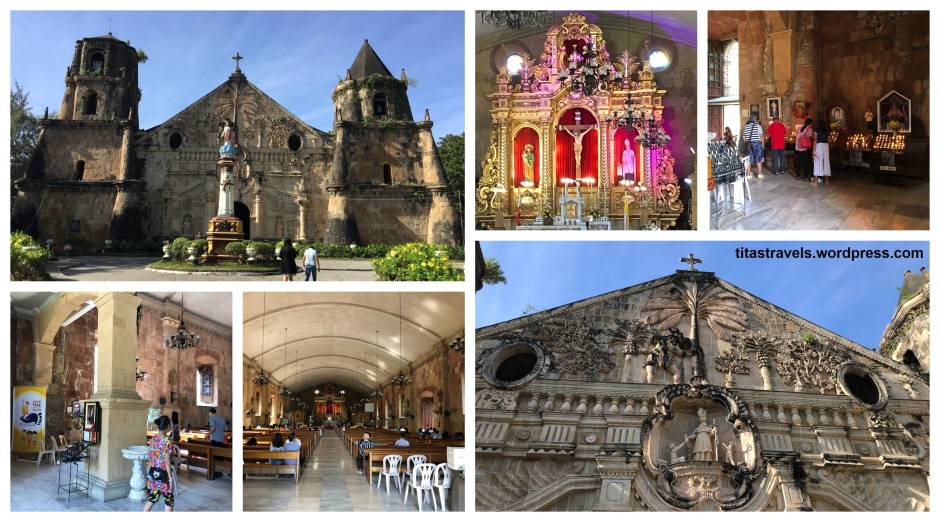
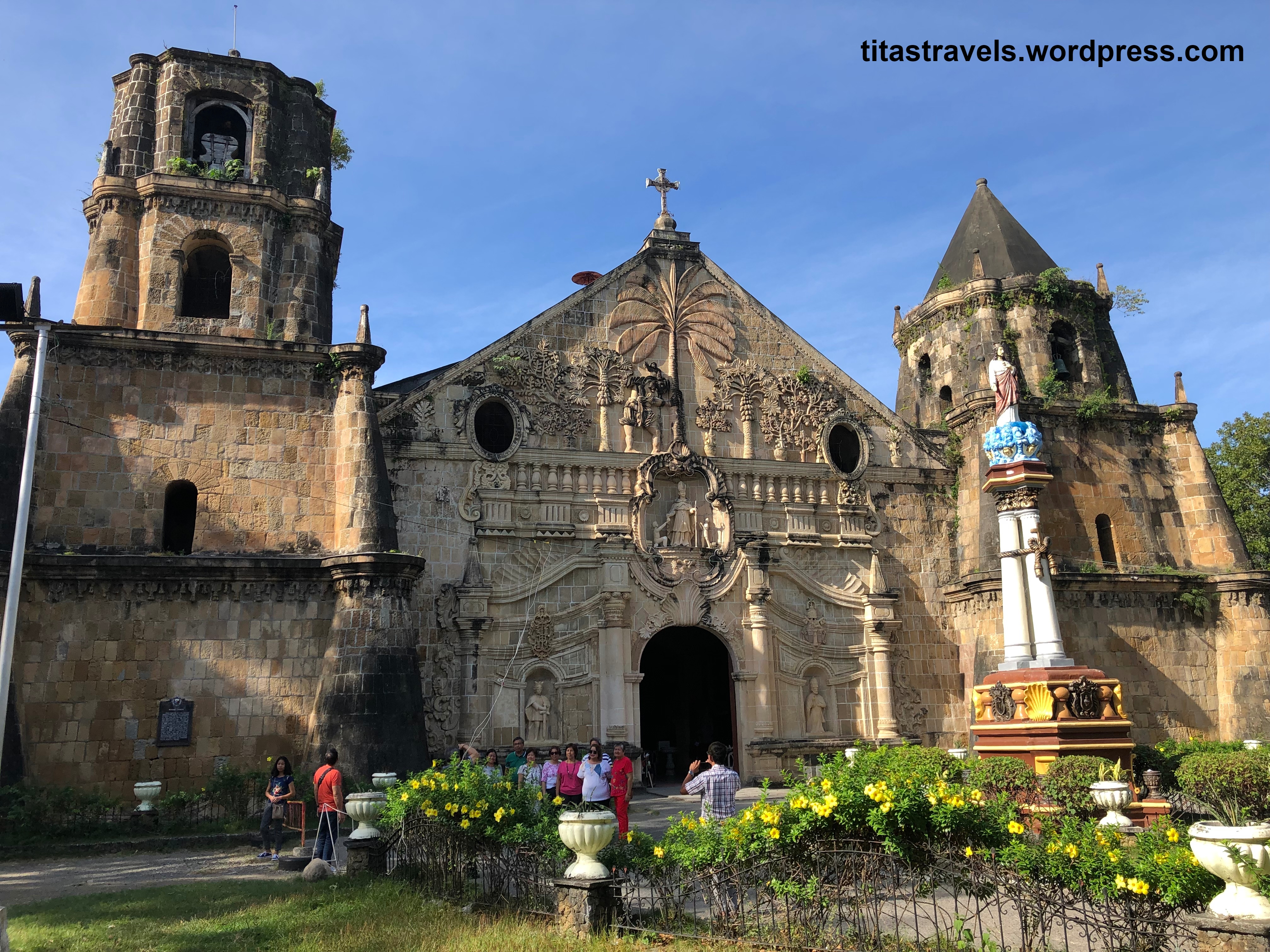



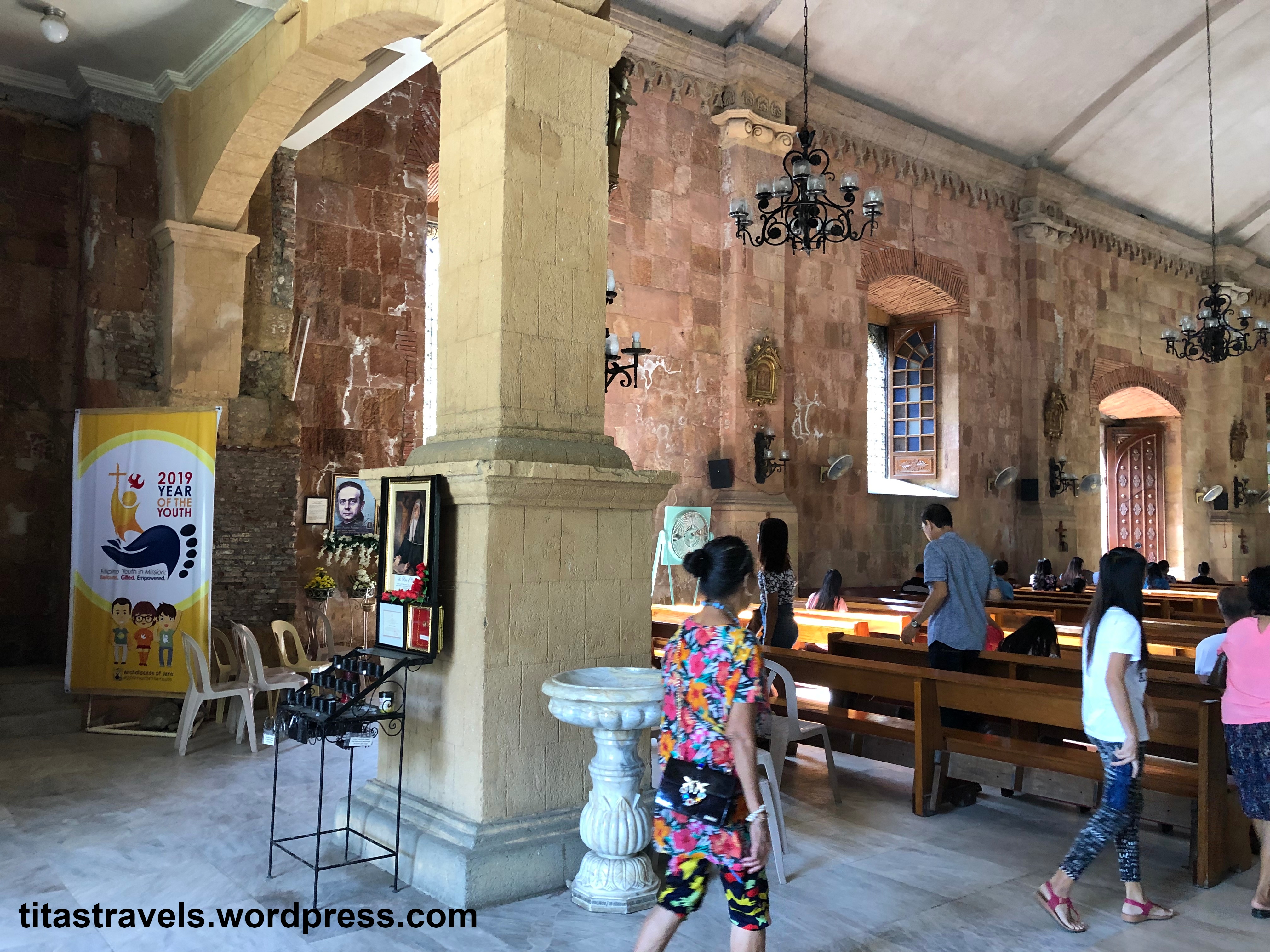



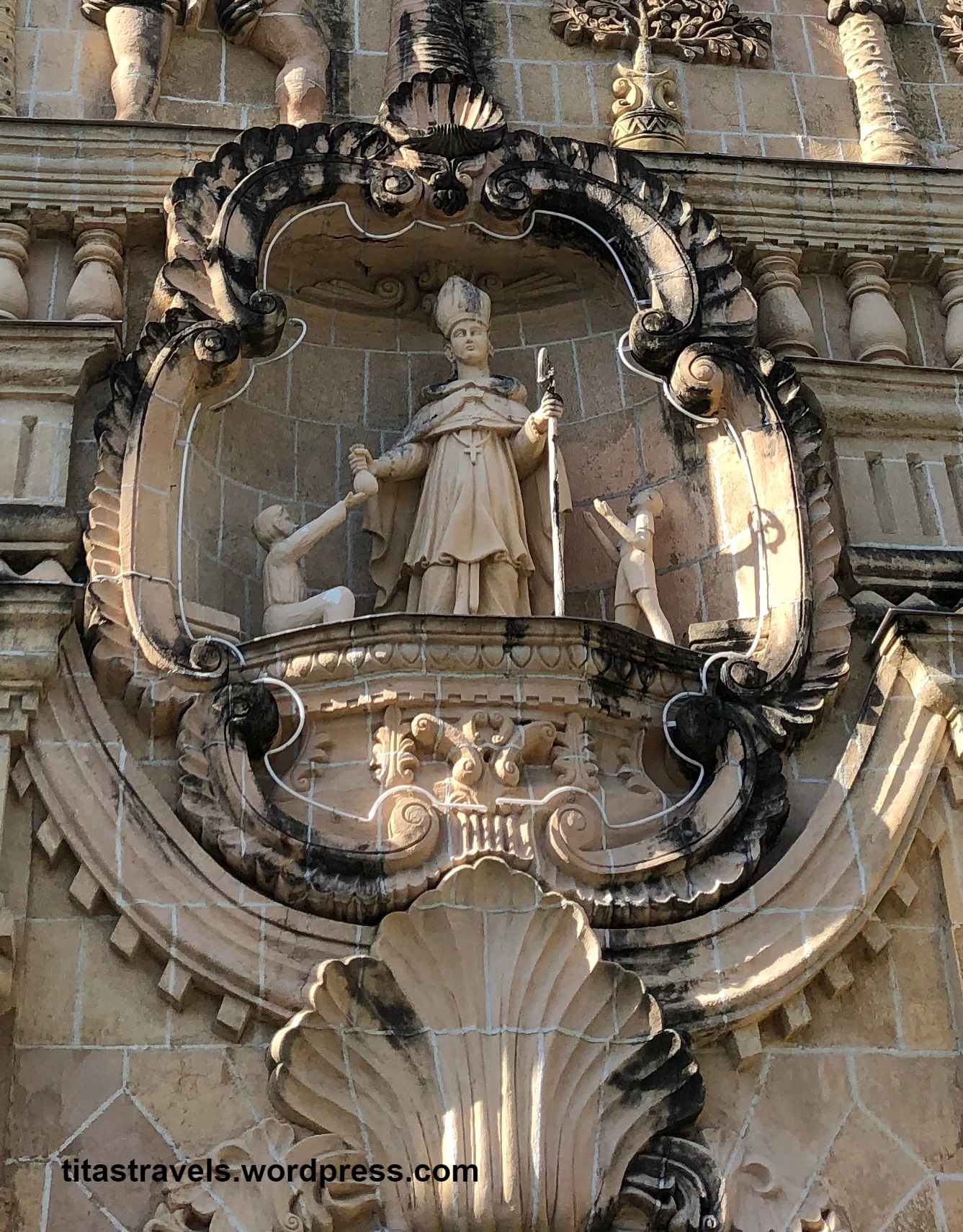




 (l-r): Miagao Church, Paoay Church, San Agustin Church and Santa Maria Church (photographers: Wowleology and Patrick Roque, featured at
(l-r): Miagao Church, Paoay Church, San Agustin Church and Santa Maria Church (photographers: Wowleology and Patrick Roque, featured at  Tubbataha Reef (photographers: Nikswieweg, Ron Van Oers and Jun V Lao, featured at
Tubbataha Reef (photographers: Nikswieweg, Ron Van Oers and Jun V Lao, featured at 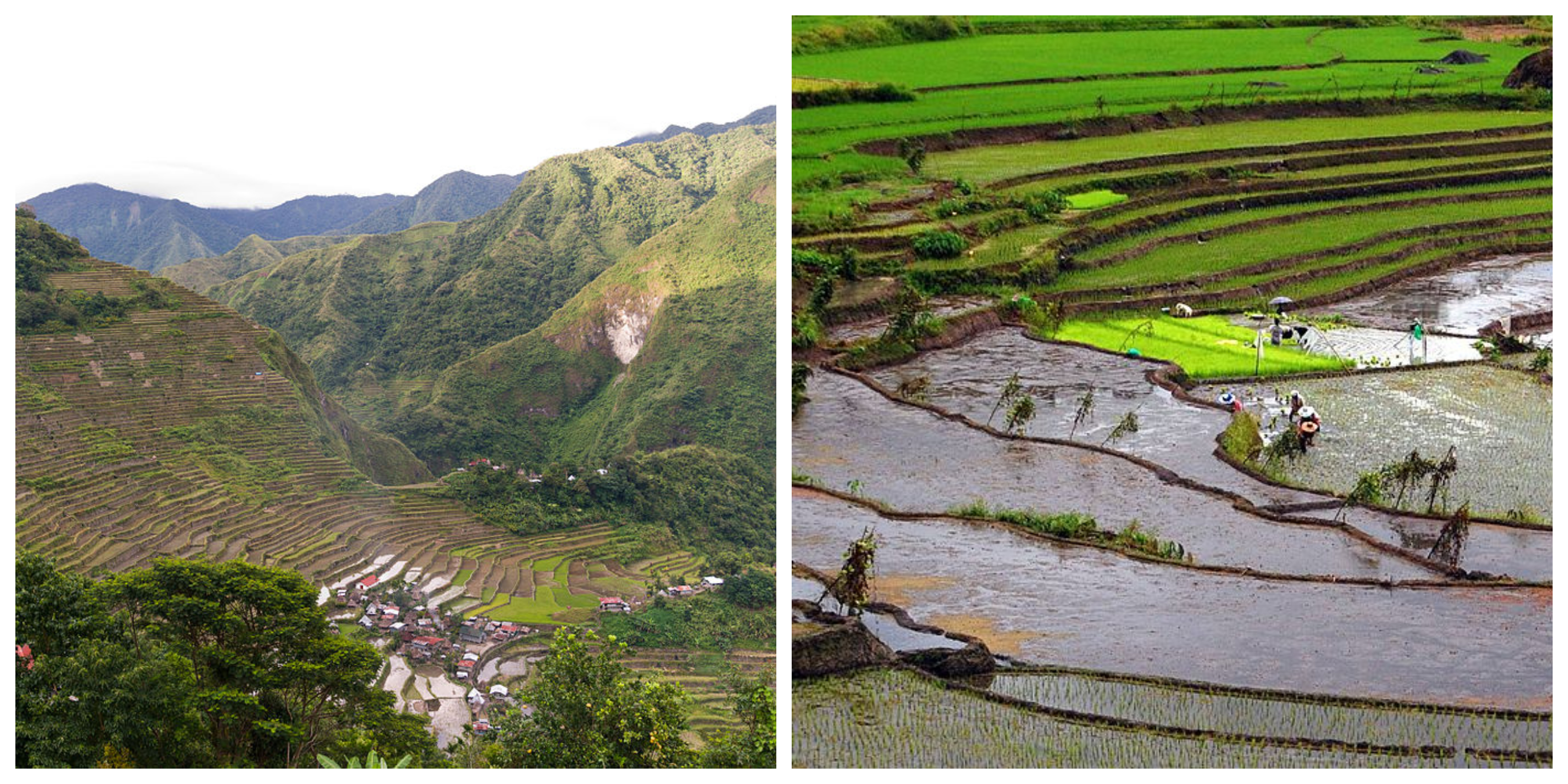 Batad Rice Terraces in Banaue and Nagacadan Rice Terraces in Kiangan (photographers: CEphoto, Uwe Aranas and Shubert Ciencia, featured at en.wikipedia.org/wiki/Rice_Terraces_of_the_Philippine_Cordilleras)
Batad Rice Terraces in Banaue and Nagacadan Rice Terraces in Kiangan (photographers: CEphoto, Uwe Aranas and Shubert Ciencia, featured at en.wikipedia.org/wiki/Rice_Terraces_of_the_Philippine_Cordilleras) Calle Crisologo, Vigan (photographer: Joelaldor,
Calle Crisologo, Vigan (photographer: Joelaldor, 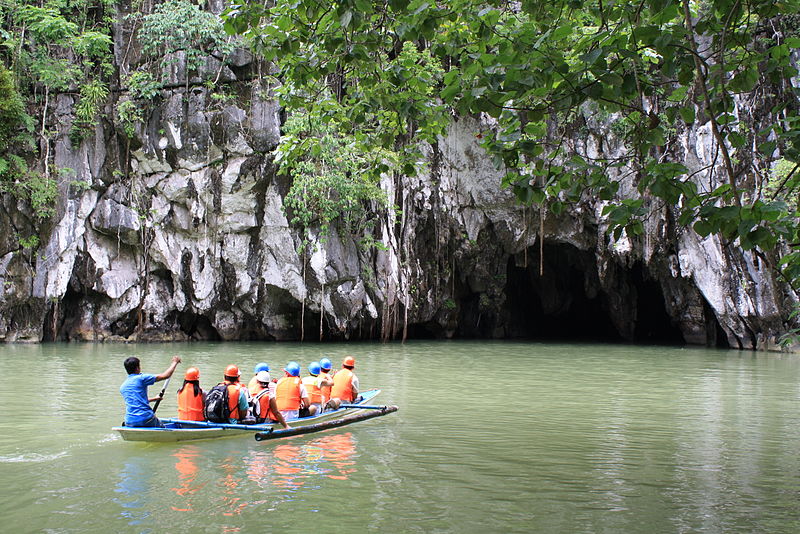 Puerto Princesa Subterranean River National Park in Palawan; photo from
Puerto Princesa Subterranean River National Park in Palawan; photo from  Mount Hamiguitan inDavao Oriental; photo from
Mount Hamiguitan inDavao Oriental; photo from